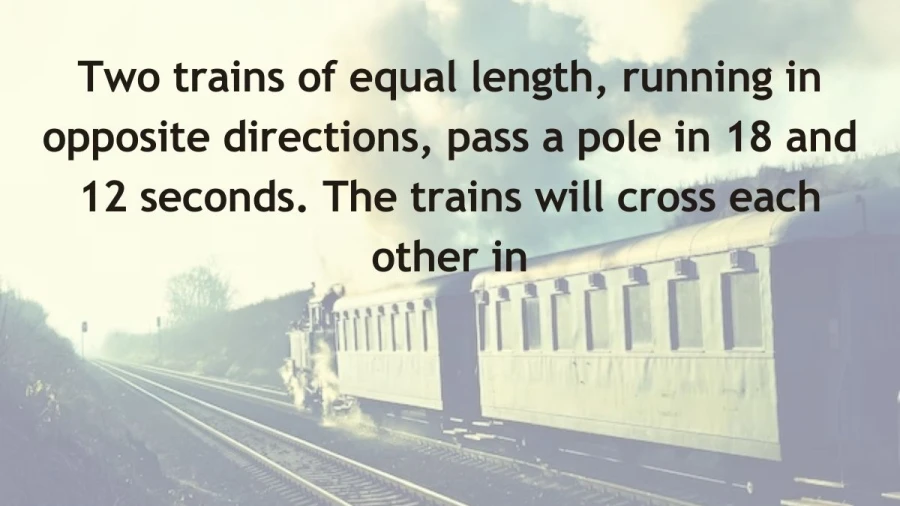If you happen to be viewing the article Two trains of equal length, running in opposite directions, pass a pole in 18 and 12 seconds. The trains will cross each other in ? on the website Math Hello Kitty, there are a couple of convenient ways for you to navigate through the content. You have the option to simply scroll down and leisurely read each section at your own pace. Alternatively, if you’re in a rush or looking for specific information, you can swiftly click on the table of contents provided. This will instantly direct you to the exact section that contains the information you need most urgently.
Find out when two trains, of equal length but traveling in opposite directions, will intersect after passing a pole in differing times of 18 and 12 seconds.
Two trains of equal length, running in opposite directions, pass a pole in 18 and 12 seconds. The trains will cross each other in
The trains will cross each other in 14.4 seconds.
To solve this problem, we first need to find the speeds of the two trains.
Let’s denote:
- s1 = speed of the first train,
- s2 = speed of the second train, and
- L = length of each train.
From the given information, we can write two equations based on the time each train takes to pass the pole:
- For the first train: s1 = L/18
- For the second train: s2 = L/12
Now, when the two trains are moving in opposite directions and crossing each other, their relative speed is the sum of their individual speeds. So, the relative speed of the two trains is s1 + s2.
Article continues below advertisement
To find when they will cross each other, we need to find how much time it takes for them to cover the combined length of both trains.
Let’s denote:
- t = time taken for the trains to cross each other.
The total distance traveled by both trains when crossing each other is 2L, as both trains together cover the lengths of both trains.
So, 2L = (s1 + s2) × t.
Substituting the expressions for s1 and s2 from the equations above:
2L = (L/18 + L/12) × t.
Now, we can solve for t:
2L = ((1/18) + (1/12)) × t. 2 = ((1/18) + (1/12)) × t. 2 = ((2/36) + (3/36)) × t. 2 = (5/36) × t. t = (2 × 36)/5. t = 72/5. t = 14.4 seconds.
So, the trains will cross each other in 14.4 seconds.
Applications of Speed, Distance, and Time in Real World
Speed, distance, and time are fundamental concepts in physics and mathematics that find applications in various real-world scenarios across different fields. Here are some examples:
Article continues below advertisement
Article continues below advertisement
-
Transportation:
- Calculating travel time and distance for vehicles, airplanes, trains, and ships.
- Determining optimal routes for navigation systems and delivery services based on speed and distance.
- Estimating fuel consumption and efficiency for vehicles based on speed and distance traveled.
-
Sports and Athletics:
- Timing and scoring events such as races, marathons, and cycling competitions.
- Analyzing athletes’ performance by measuring speed and distance covered during training sessions and competitions.
- Determining average speed and pace in endurance sports like running, cycling, and swimming.
-
Construction and Engineering:
- Planning construction schedules based on the time required for workers and equipment to travel between sites.
- Calculating the speed and distance traveled by vehicles and machinery on construction sites.
- Estimating the time needed to complete projects based on the speed of construction activities.
-
Logistics and Supply Chain Management:
- Optimizing logistics operations by calculating transit times and distances between warehouses, distribution centers, and retail locations.
- Scheduling shipments and deliveries based on travel time and distance.
- Managing inventory levels and reorder points by considering lead times and transportation times.
-
Emergency Services:
- Estimating response times for emergency services such as ambulances, fire trucks, and police cars.
- Determining the best routes for emergency vehicles to reach incident locations quickly.
- Calculating the time it takes for rescue teams to reach remote or inaccessible areas.
-
Science and Research:
- Analyzing motion and velocity in physics experiments and simulations.
- Studying the movement patterns of celestial objects such as planets, stars, and galaxies.
- Measuring the speed and distance of objects in astronomy and astrophysics.
-
Health and Fitness:
- Monitoring physical activity and exercise routines using fitness trackers and wearable devices.
- Tracking running, walking, and cycling workouts by recording speed, distance, and time.
- Setting goals and evaluating progress based on improvements in speed, endurance, and distance covered.
These are just a few examples of how speed, distance, and time are used in the real world. These concepts are fundamental to many aspects of everyday life and are essential for problem-solving and decision-making in various fields.
Thank you so much for taking the time to read the article titled Two trains of equal length, running in opposite directions, pass a pole in 18 and 12 seconds. The trains will cross each other in written by Math Hello Kitty. Your support means a lot to us! We are glad that you found this article useful. If you have any feedback or thoughts, we would love to hear from you. Don’t forget to leave a comment and review on our website to help introduce it to others. Once again, we sincerely appreciate your support and thank you for being a valued reader!
Source: Math Hello Kitty
Categories: Math

